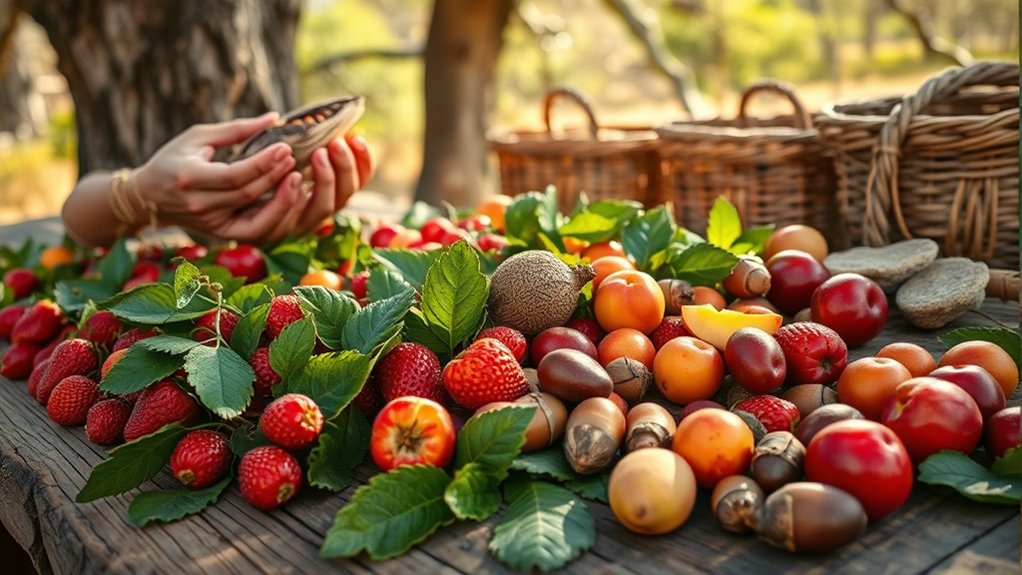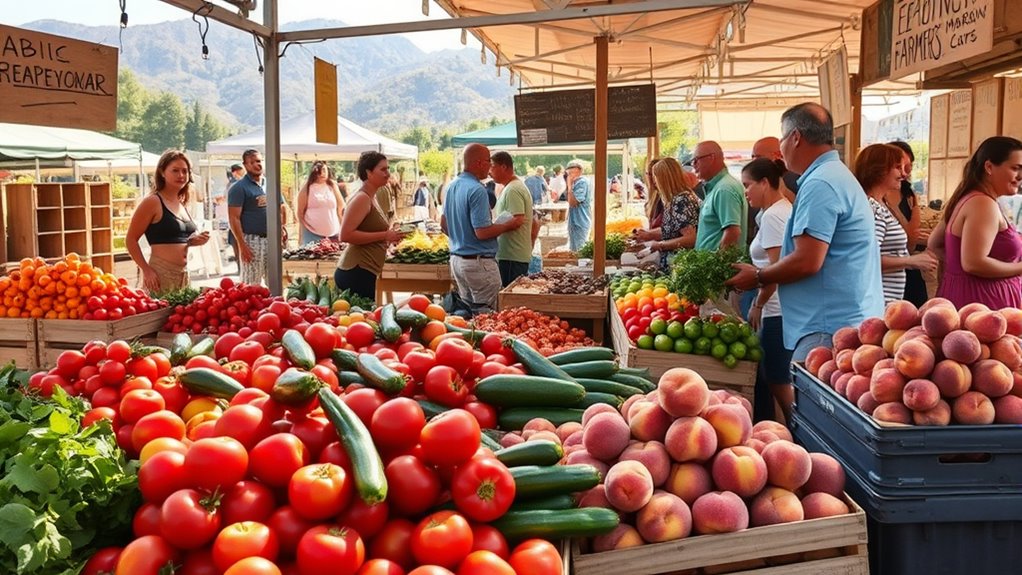California and Nevada’s cuisine reflects a vibrant blend of indigenous foraging, immigrant influences, and modern innovation. You’ll find traditional dishes like tri-tip, seafood cioppino, Mexican classics, Asian-inspired rice and sauces, and farm-fresh produce. Farmers markets showcase seasonal ingredients, while multicultural traditions create exciting fusion flavors. If you want to explore how native practices, regional influences, and culinary creativity shape these regions, there’s plenty more to discover beyond the surface.
Key Takeaways
- California and Nevada feature diverse cuisines blending indigenous, immigrant, and regional influences, emphasizing fresh, local, and sustainable ingredients.
- Iconic dishes include tri-tip, cioppino, California roll, and Basque lamb stews, reflecting regional agricultural and cultural roots.
- Multicultural fusion, such as Mexican, Asian, Italian, and Middle Eastern flavors, shapes the vibrant culinary landscape.
- Farmers markets and seasonal produce are central, promoting farm-to-table practices and supporting local farms.
- Modern culinary innovations focus on minimal processing, artistic presentation, and honoring traditional techniques and ingredients.
Indigenous Foundations and Foraging Traditions

The indigenous peoples of California and Nevada have long relied on foraging and hunting to sustain their communities, shaping a deep connection with the land. You’d gather acorns, pine nuts, berries, and wild plants, carefully harvesting to preserve natural resources. Hunting provided deer, rabbits, and waterfowl, while fishing for cutthroat trout and freshwater fish was essential. You’d cook using roasting, boiling, and drying methods, ensuring food preservation and respect for the environment. These practices weren’t just about sustenance—they reflected a sustainable relationship with the ecosystem. By understanding seasonal patterns and respecting nature’s balance, you maintained a tradition of responsible gathering that supported your community’s well-being. This deep-rooted knowledge shaped your ancestors’ diets and cultural identity for generations, emphasizing the importance of sustainable harvesting practices to maintain ecological harmony.
European Settlement and Early Culinary Fusion

How did European settlers influence California’s early culinary landscape? You’d find that immigrants from Italy, Ireland, Cornwall, and the Basque region brought their hearty stews, pies, breads, and roasting traditions, shaping local foodways. Basque immigrants introduced mutton, lamb stews, and sheep dairy products like cheese, adding new flavors to the region. Chinese immigrants contributed rice, pickled vegetables, dried fruits, and sauces, integrating local produce into their cuisine. Cornish miners brought meat pies called pasties, which became a staple. These early settlers adapted their homeland recipes with local ingredients, creating a culinary fusion**** that laid the groundwork for California’s diverse culinary identity. Their influence is visible in hearty dishes, baked goods, and preserved foods that blended tradition with new surroundings.
Spanish-Mexican Heritage and Its Regional Influences

European settlers’ influence on California’s early culinary landscape extended beyond their hearty stews and baked goods, integrating deeply with Native and other immigrant traditions. You’ll find that Spanish and Mexican heritage shaped many regional dishes, blending indigenous ingredients with European techniques. Staples like enchiladas, tamales, and tortillas became common, often featuring black olives as a signature regional ingredient. During the mission era, European livestock, wheat, citrus, and olives were introduced, transforming agriculture and cuisine. Mexican ranchers in the 1840s started California-style barbecue, emphasizing beef, pork, and oak-smoking methods. Santa Maria-style barbecue, with tri-tip, pinquito beans, and fresh salsa, epitomizes this regional influence. These culinary traditions reflect a vibrant fusion rooted in history, geography, and multicultural exchanges that continue to define California’s unique food identity. Additionally, the use of traditional cooking tools and techniques, such as open-flame grilling and cast-iron cookware, has preserved many of these culinary methods over generations.
Iconic California/Nevada Dishes and Inventive Foods

You’ll find that California and Nevada are famous for their unique dishes and creative food inventions rooted in regional traditions. From the iconic tri-tip and California roll to hidden Valley Ranch dressing, these foods showcase a blend of history and innovation. Exploring how traditional flavors fuse with modern techniques reveals the vibrant culinary landscape of the region. Additionally, the influence of diverse cultural backgrounds, such as Asian and Latin American cuisines, enriches the local food scene with fusion cuisine that reflects the multicultural makeup of the area.
Regional Specialties and Origins
California and Nevada boast a vibrant culinary landscape shaped by their diverse histories and regional ingredients. You’ll find iconic dishes like Santa Maria-style barbecue, featuring tri-tip cooked over native red oak coals, served with pinquito beans and salsa. In California, dishes such as taquitos reflect persistent Mexican influence, while the region’s inventive foods include the California roll and French dip sandwich. Local specialties also come from immigrant traditions—Basque lamb stews, Chinese rice and sauces, and Cornish pasties. The state’s rich agricultural roots contribute to vibrant flavors, from citrus and olives to unique cheeses like Jack cheese. These regional specialties highlight a blend of native ingredients, immigrant influences, and inventive culinary traditions that define California and Nevada’s distinctive food culture.
California Culinary Inventions
Among California’s many culinary innovations, several dishes and food products stand out as symbols of the region’s inventive spirit. The California roll transformed sushi, blending fresh seafood with avocado and cucumber, making Japanese cuisine more accessible. The French dip sandwich, originating in Los Angeles, features thinly sliced roast beef served with flavorful au jus, showcasing local culinary creativity. Cioppino, a seafood stew born in San Francisco, combines various fresh catches with a rich tomato base, embodying coastal resourcefulness. Hidden Valley Ranch dressing, invented in the 1950s, revolutionized salads nationwide. The creation of Doritos, a bold flavored snack, and the iconic Mai Tai cocktail reflect California’s flair for bold, innovative flavors. These inventions highlight California’s unique ability to reinvent and adapt culinary traditions. Regional culinary innovation continues to be a hallmark of California’s vibrant food culture, inspiring chefs and food lovers alike.
Fusion of Traditional and Modern
The fusion of traditional and modern culinary practices in California and Nevada creates a vibrant tapestry of dishes that reflect both history and innovation. You’ll find iconic creations like the California roll, blending Japanese ingredients with local produce, and the French dip sandwich, born from California’s diverse influences. Modern chefs reinvent classics, adding fresh, seasonal ingredients and global flavors, while preserving regional roots. For example, Santa Maria-style barbecue now emphasizes sustainable practices, and inventive dishes like cauliflower-based tacos honor Native ingredients. This dynamic culinary landscape celebrates authenticity with a creative twist, showcasing how historic foodways evolve through contemporary techniques. Whether enjoying farm-to-table dishes or globally inspired fusion plates, you experience a culinary scene rooted in tradition yet constantly pushing boundaries. Best Beaches provide an inspiring backdrop for many of these innovative dining experiences.
Modern California Cuisine and Culinary Innovation

Modern California cuisine has revolutionized the culinary scene by emphasizing fresh, local, and sustainable ingredients. You’ll find chefs blending global techniques with Californian produce to create vibrant, seasonal dishes. This approach champions minimal processing and artistic presentation, highlighting the region’s diversity. Influential figures like Alice Waters pioneered this movement, inspiring chefs such as Jeremiah Tower and Jonathan Waxman. The cuisine’s core is a “farm-to-table” philosophy that celebrates local farms and artisanal products. To visualize, consider the following:
| Ingredient Type | Preparation Style | Typical Dishes |
|---|---|---|
| Fresh produce | Raw, roasted, sautéed | Salads, roasted vegetables |
| Local seafood | Grilled, ceviche | Cioppino, fish tacos |
| Artisanal dairy | Cheese-making, aging | Sheep cheese, Jack cheese |
| Sustainable meats | Grilled, braised | Tri-tip, roasted chicken |
Additionally, ongoing innovations in food safety ensure that these ingredients are not only fresh but also meet high standards for consumer health.
The Role of Farmers Markets and Local Produce

You can experience California and Nevada’s vibrant food scene by visiting farmers markets that showcase seasonal harvest highlights and support local farmers. These markets offer a wide variety of fresh ingredients, from ripe fruits and vegetables to artisanal products. By shopping locally, you help sustain regional agriculture while enjoying the freshest, most flavorful produce available. Incorporating local food systems into your diet can also reduce your environmental impact and promote sustainable practices.
Seasonal Harvest Highlights
How do farmers markets and local produce shape California and Nevada’s culinary landscape? They drive a vibrant, seasonal rhythm that celebrates fresh ingredients at their peak. When you visit a farmers market, you’ll find a colorful array of fruits, vegetables, herbs, and specialty items that reflect the region’s diverse climate and soil. These markets encourage chefs and home cooks alike to craft dishes featuring ripe strawberries, heirloom tomatoes, tender greens, or seasonal melons. Relying on local harvests guarantees your meals are flavorful, nutrient-rich, and sustainable. It also supports regional farmers, preserves traditional farming practices, and keeps the culinary scene dynamic. By embracing seasonal produce, you become part of a tradition that champions freshness, local pride, and culinary innovation rooted in the land’s natural bounty. Wall organization systems can also be utilized in kitchens and dining areas to enhance visual appeal and functionality while displaying beautiful serveware and table linens that complement seasonal themes.
Supporting Local Farmers
Supporting local farmers plays a vital role in maintaining the vibrant culinary scene of California and Nevada. When you shop at farmers markets or buy directly from growers, you’re getting fresh, seasonal produce that captures the region’s diverse climate and soil. This support helps sustain small farms, preserves farmland, and encourages sustainable practices. By choosing local, you reduce the carbon footprint associated with long-distance transportation and promote food security. Farmers markets often feature heirloom vegetables, organic fruits, and artisanal products that aren’t available in supermarkets. Your participation in this local food movement keeps culinary traditions alive and fosters community connections. Additionally, understanding the cost of home security systems can help residents protect their investments and ensure their farms and homes are secure. Ultimately, supporting local farmers enriches your dining experience while contributing to a resilient, environmentally conscious food system.
Fresh Ingredient Variety
Farmers markets and local produce play a crucial role in showcasing California and Nevada’s diverse agricultural bounty. They give you direct access to seasonal fruits, vegetables, herbs, and artisanal products that define regional flavors. This variety allows you to experiment with fresh ingredients in your cooking, highlighting local specialties. You might find heirloom tomatoes perfect for salads or fresh citrus for zest and juice. Local producers also offer unique items like regional cheeses, honey, and dried fruits. Supporting these markets helps sustain small farms and preserves culinary traditions. By choosing local, you guarantee your meals are vibrant, flavorful, and eco-friendly.
- Seasonal fruits and vegetables unique to each region
- Artisanal cheeses, honey, and preserved goods
- Fresh herbs and locally sourced seafood
- Regional specialties like tri-tip and pinquito beans
Multicultural Influences in Contemporary Food Scenes

Contemporary food scenes across California and Nevada are vibrant mosaics shaped by a rich tapestry of multicultural influences. You’ll find a mix of flavors that reflect immigrant traditions and modern innovation. Italian, Mexican, Asian, and Middle Eastern cuisines blend seamlessly in urban neighborhoods and farm-to-table spots. Imagine:
| Cuisine | Signature Dishes | Influences |
|---|---|---|
| Italian | Pasta, Risotto | European roots, local ingredients |
| Mexican | Tacos, Tamales | Native ingredients, Spanish heritage |
| Asian | Sushi, Ramen | Japanese, Chinese, Korean traditions |
| Middle Eastern | Shawarma, Hummus | Levantine flavors, Mediterranean style |
| Fusion | California Roll, Korean Tacos | Global blending, creative innovation |
This melting pot results in dynamic menus that celebrate diversity, pushing culinary boundaries while honoring historic roots.
The Impact of Tourism on Regional Food Culture

Tourism considerably shapes regional food culture by driving demand for authentic local dishes and innovative dining experiences. As visitors seek unique flavors, local chefs and restaurants adapt, blending tradition with modern flair. This dynamic promotes culinary diversity and keeps regional specialties alive. You’ll notice farmers markets thriving with seasonal produce to meet tourist interest, and high-end restaurants offering locally inspired menus. Tourists also influence the popularity of iconic dishes like tri-tip or California rolls, spreading regional flavors beyond borders. Additionally, food festivals and events attract crowds enthusiastic to taste local heritage. This influx encourages innovation while preserving culinary roots. Overall, tourism fuels a vibrant, evolving food scene that celebrates California and Nevada’s rich, multicultural flavors and culinary creativity.
Celebrating Food Heritage Through Festivals and Events

Festivals and events play a vital role in honoring California and Nevada’s rich food heritage by showcasing traditional flavors and culinary practices. You can experience vibrant celebrations like California’s Gilroy Garlic Festival or Nevada’s Great Nevada Fair, where local produce, specialty dishes, and historic recipes take center stage. These gatherings often feature cooking demonstrations, tastings, and storytelling that connect you to indigenous, immigrant, and regional food traditions. For example, you might savor tamales, tri-tip, or fresh seafood while learning about their cultural significance. Food festivals also promote sustainable, farm-to-table practices, emphasizing locally sourced ingredients. Participating in these events allows you to deepen your appreciation for the diverse culinary history of California and Nevada, making food a shared celebration of their vibrant cultural identities.
Frequently Asked Questions
How Have Indigenous Food Practices Influenced Modern California Cuisine?
You can see indigenous food practices influence modern California cuisine through the use of local, seasonal ingredients like acorns, pine nuts, and wild plants. Chefs incorporate traditional foraging techniques and sustainable methods, emphasizing fresh, native flavors. Dishes often highlight wild game, freshwater fish, and native herbs, honoring indigenous relationships with the land. This connection to nature and sustainability continues to shape California’s innovative culinary scene today.
What Role Did Early European Immigrants Play in Shaping Regional Foodways?
You know what they say, “You are what you eat.” Early European immigrants shaped regional foodways by introducing stews, pies, breads, and roasting traditions from their homelands. They adapted recipes using local ingredients, blending Italian, Irish, Basque, and Cornish influences. Their culinary footprint includes hearty mutton stews, meat pies, and bread, laying the foundation for California’s diverse and innovative food scene today.
How Does California’s Diverse Heritage Influence Contemporary Fusion Dishes?
California’s diverse heritage fuels its vibrant fusion dishes by blending ingredients and techniques from Native, Spanish, Mexican, Asian, and European cuisines. You’ll find fresh produce, bold spices, and innovative cooking methods coming together in dishes like sushi burritos, Korean tacos, and Mediterranean-inspired salads. This culinary creativity reflects your local multicultural influences, encouraging you to explore new flavors and appreciate how tradition and innovation merge seamlessly on your plate.
What Are Some Lesser-Known Regional Specialties Unique to Nevada County?
In Nevada County, you’ll find unique regional specialties like hearty tri-tip barbecue, often cooked over native red oak coals, and pinquito beans served alongside. You might also enjoy locally crafted cheeses, including sheep cheese and Jack cheese, reflecting dairy traditions. Don’t miss the vibrant farmers markets showcasing seasonal produce, or local eateries serving Mexican-inspired dishes like tamales and authentic street tacos, blending tradition with modern flavors.
How Do Festivals Celebrate California and Nevada’s Culinary History?
You’ll find that festivals celebrate California and Nevada’s culinary history through lively events showcasing local dishes, traditional recipes, and regional ingredients. You participate in tastings of tri-tip, tamales, and fresh seafood, often paired with storytelling about their origins. These events highlight multicultural influences, from Native foraging to immigrant innovations, and emphasize farm-to-table practices. You can enjoy cooking demonstrations, music, and community bonding that honor the rich, diverse culinary heritage of the region.
Conclusion
So, next time you’re munching on farm-fresh kale or savoring fusion tacos, remember—you’re just tasting centuries of indigenous, Spanish, Mexican, and modern innovation simmered together in California and Nevada’s culinary pot. It’s a culinary mosaic with a dash of tourism, a sprinkle of multicultural flair, and a generous helping of creative genius. Bon appétit, or as they say here, “Eat up—history’s served on a plate!”









